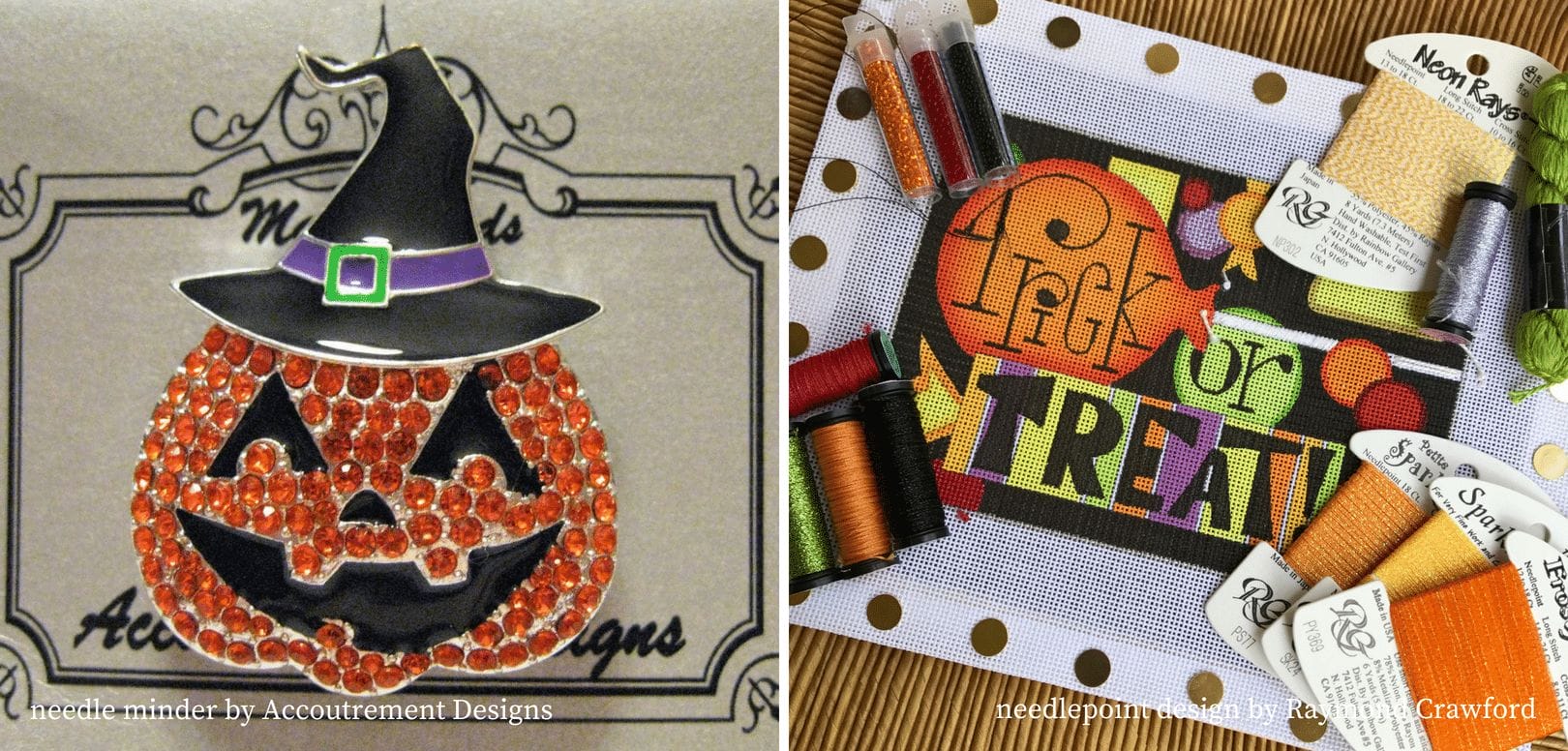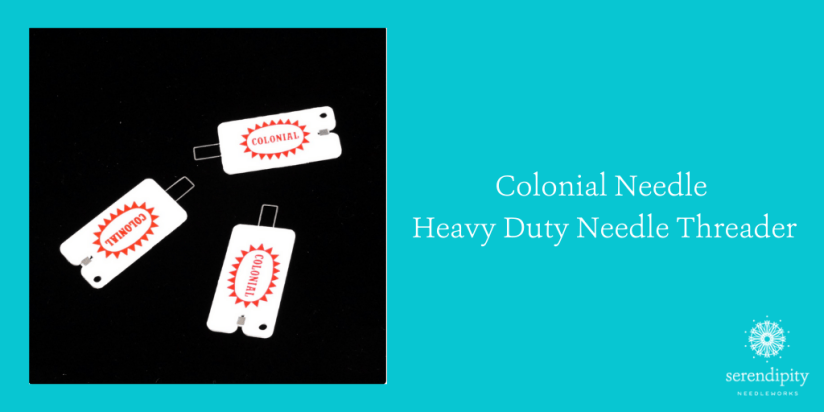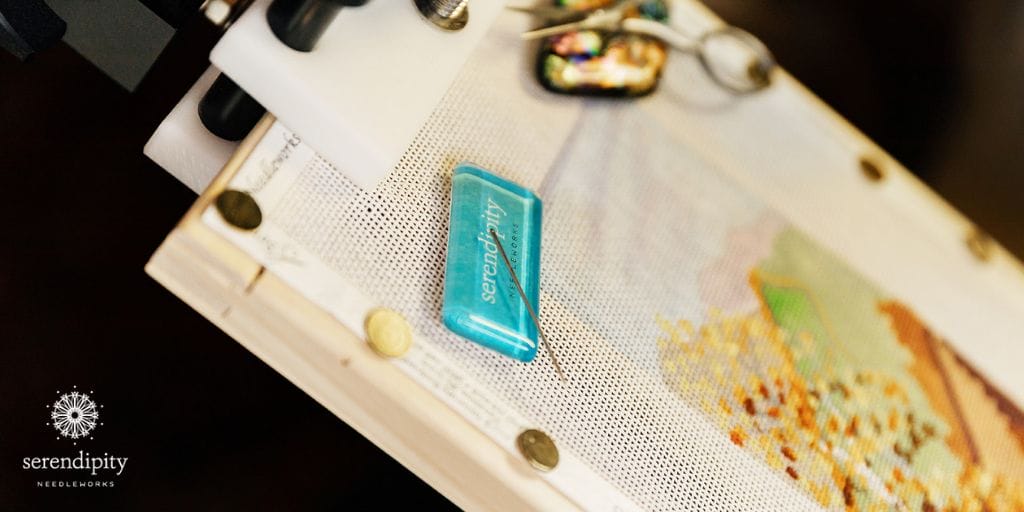Which needlepoint tools and gadgets do you have in your needlepoint workbasket?
There are dozens of options available to today’s stitcher, and that makes it even harder to know what’s “critical” and what’s simply “nice to have”. So, today, we’re going to talk about the essentials. Those tools and accessories that you really should have in order to get the most enjoyment out of your needlepoint hobby. Sound good? Terrific! Let’s dive in…
First, you need scissors – at least a couple of pairs.
You need a really good pair for cutting non-metal/non-metallic threads. They should have sharply pointed tips so you can clip threads in tight spaces.
My favorites are my 4″ Gingher embroidery scissors with large handles.
The holes are extra big, so my fingers don’t get stuck. That’s them in the picture below.
They have a leather sheath, too, which is super-handy because there’s not much worse than finding that your scissors “accidentally” cut part of your project – or your lovely project bag – while you were toting it around.
Oh, and there’s an added bonus…that little sheath protects the fine pointed tips from being damaged when they’re bouncing around inside your bag.

You also need a pair of scissors for your metal/metallic threads.
Any small pair of scissors will work.
I have an old pair of dull embroidery scissors that I use for this task. (If you’re using sharp-tipped embroidery scissors to cut your metal/metallic threads, be sure and use some type of sheath or point protector on them, too. They can still wreak havoc, even if they’re dull.)
And you need an assortment of needles.
Yes, you need an assortment of different sized tapestry needles, but did you know that you really ought to have a variety of different kinds of needles, too?
What kinds of needles do you need?
My best suggestion is to keep Beading, Bullion, Chenille, Crewel, Mattress, and Milliners needles in a pouch. Then, you’ll have any kind of needle you might need right at your fingertips.
Beading needles are used to attach beads to your canvas.
Duh, right?! (Tee hee!) 😉 My absolute all-time favorites are size 10 beading needles by Bohin. I don’t use anything else.
Bullion needles are used for making bullion knots.
Colonial Needle has a terrific set that’s perfect for needlepoint. The set includes 3 different lengths and each needle has a blunt tip – just like a tapestry needle.
Chenille needles have a couple of purposes in needlepoint.
I use them for couching threads – and they’re my “go-to” needle for all kinds of silk ribbon embroidery. They look very much like tapestry needles, but they have a sharp point.
Crewel needles are the bees knees for surface embroidery on fabric…
but they also serve a purpose in needlepoint. They’re much smaller (both in length and diameter) than tapestry needles. They’re terrific for gathering ribbon and attaching appliqués and findings. And they’re also great for couching.
Wonder why you need a mattress needle?
I thought you might! 😉
A mattress needle is a really good substitute for a laying tool. Mattress needles are a lot less expensive than laying tools, too, which means that they’re a terrific option for beginning stitchers. Just thread a ribbon through the eye to keep track of it.
And Milliners needles are great for adding tiny details…
(like French knot eyes, bullion stitch butterfly antennae, etc.) to your projects.
They’re the same diameter – from the eye end to where they taper at the tip.
Why does that matter? Well, when you’re working French knots and bullion stitches, the wrapped thread slides down and over the eye ever so much easier because of that nifty little feature.
Of course, there’s a laying tool…
Okay. There are several, but I reeaaalllly like laying tools. They’re so pretty – and so functional – and oh-so-collectible! 😉
Not sure what the heck a laying tool is?
A laying tool is a little stick that you can use to keep your threads under control.
And a laying tool is essential when you work with more than one strand of a divisible thread in your needle. Use it to stroke the strands and keep them flat, so they lay smoothly on the surface of your canvas – or to tension your thread as you make a stitch.
Wood and metal laying tools are the most common, but you can also find them made of glass, bone, plastic – and even porcupine quills! You may also use a trolley needle, a mattress needle, or a large tapestry needle as a laying tool if you prefer.
Most needlework shops carry a variety of different kinds, so you can test drive one before you make a purchase. (And I highly recommend test driving anything that costs more than $25, if at all possible.)
Eye spy…a needle minder, too.
A needle minder is really just a fancy magnet, and it comes in super handy when you’re stitching. Just pop it onto your canvas and – Voilá! You have a handy place to park your threaded needle between stitching sessions.
Did I mention that these little beauties are collectible, too? In fact, I know several stitchers who like to match their needle minder to their project… like this jack-o-lantern needle minder paired with a cutie-pie Halloween canvas.

And finally, there’s the ever helpful – and essential – needle threader.
It may seem like such a wee tiny thing to get soooo excited over, but these little gadgets have saved my sanity more times than I can count!
Yes, I have magnifiers that can help my poor ole eyes, but it’s not just seeing the eye of the needle that’s the problem.
I have limited time available to stitch and I don’t want to spend a single precious minute more than I absolutely have to with threading a needle.
All you have to do with these little gems is pop the hook into the eye of your needle, push the end of your thread through the wire, and pull! Then, my friend, you’re GOLDEN!
Just grab that threaded needle and start stitching!
Here’s a picture of my all-time favorite needle threader, in case you want to grab one for your project bag, too. (I mainly use the Tapestry/Chenille set, but the Threader Collection is mighty handy, too.)
You can get them here from Chandail Needlework in Houston, Texas.

What are your favorite needlepoint tools or gadgets?
Tell me in the comments box below. I can’t wait to hear from you!
And if you missed this week’s episode of Needlepoint TV™, click here to hop over and watch to learn more about my all-time fave needlepoint tool. 😉
Alrighty – that’s all for now, my friend!
Until next time, happy stitching…
XOXO!!






Love it. Can you tell me the name of the magnifying glasses you once had talked about?
I’m so glad you found the info in this blog post helpful, Joan! The magnifying glasses that I use are called CraftOptics. They actually have a special offer going on right now. You can learn more about the glasses – and the special offer – here.
And be sure to use my special coupon code to save $125 if you decide to buy a pair. (The code is ELLENJOHNSON.)
Have a terrific rest of your day and happy stitching!!
XOXO!
Ellen
I find it’s far cheaper to get my ophthalmologist to write a prescription for needlework glasses than buying the magnifying craft eyewear.
Hi Mary Sue
Thank you for sharing your thoughts with us here. It’s great to have an ophthalmologist who understands the needs of people who do needlepoint. 🙂 I’m glad you have a resource that you trust.
All the best,
Ellen